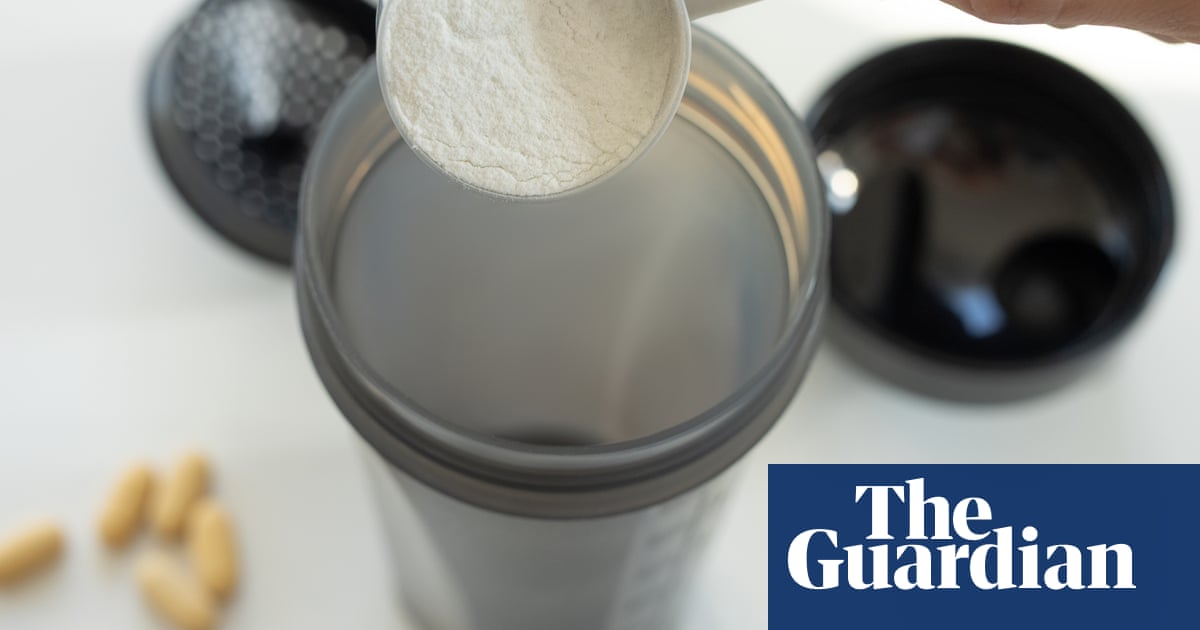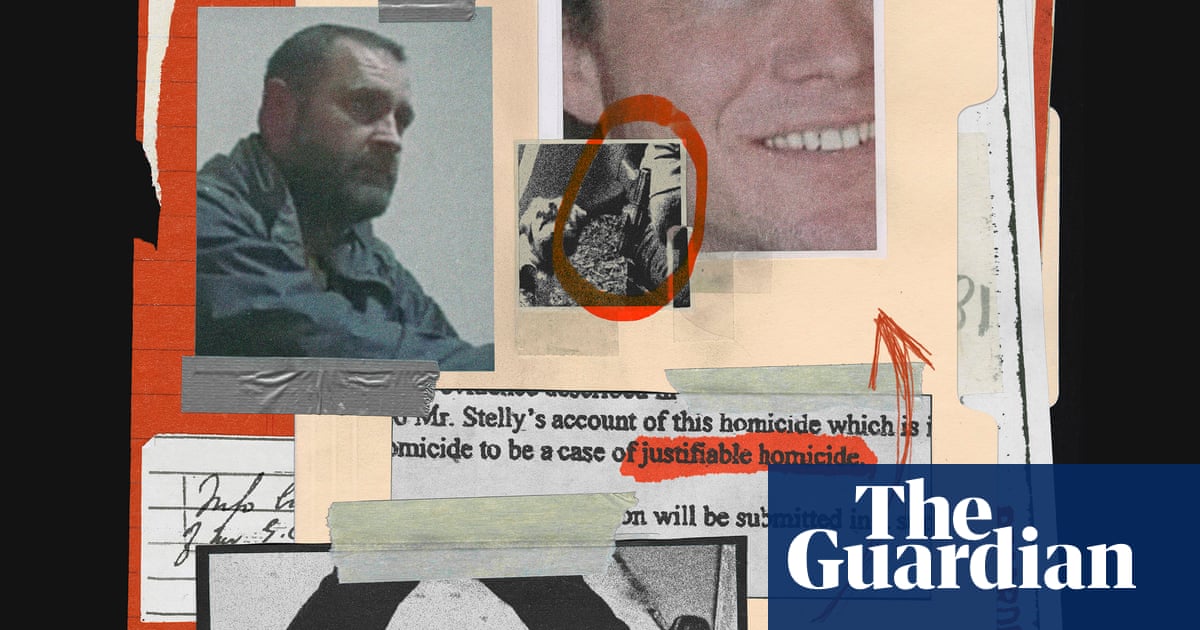“You’ve got an old one, huh?” asks James Lewis, eyeing the bottle of Tylenol with suspicion.
“No, just off the shelf today,” replies a voice off camera.
“You think I’m going to open this and get my fingerprints all over it?” Lewis asks, examining the bottle and finding it well sealed. “I’m going to poke a hole in it. I’ve got the nails for that. Well, they’re considerably smaller than they used to be. I haven’t had one of these in my hands for a long time.”
Then he’s had enough. “Oh, let’s put that away. That might scare people.”
Persuading Lewis to appear on camera was a coup for the makers of a new Netflix docuseries exploring a 1982 series of poisonings that resulted in the deaths of seven people in the Chicago area after they ingested Tylenol capsules laced with cyanide.
Cold Case: The Tylenol Murders tells how Lewis, who sent a letter to Johnson & Johnson demanding $1m to stop the killings, came under suspicion but was only convicted of extortion. Despite extensive efforts, including a nationwide search and the involvement of the FBI, the perpetrator of the poisonings has never been identified or apprehended.
The three-part docuseries by the Israeli directors Yotam Guendelman and Ari Pines recalls how the deaths caused widespread panic and had a profound impact on consumer product safety regulations and the pharmaceutical industry. It examines lingering questions surrounding the investigation, the role of Johnson & Johnson and the possibility of other suspects.
In a virtual interview from Tel Aviv, Guendelman says: “What sparked our imagination about this story was when we realised the reason why we can’t open our medical bottles or water bottles is because of the safety seals that were invented basically because this story. This is how we got into this story just by accident.
“When we realised it still is an open case, and has such a twisty, turny narrative to go by, we were hooked and we were actually shocked nobody ever told this definitive story about what was the biggest true crime story in America in the 80s.”
Featuring interviews with people involved in the original investigation, victims’ families and Lewis himself, Cold Case: The Tylenol Murders sets out how the most popular pain reliever became a source of dread. The nightmare began when 12-year-old Mary Kellerman, from Elk Grove Village, Illinois, felt sick one morning, took a Tylenol capsule, dropped to her bathroom floor and died soon after.
On the same day, less than 10 miles away, Adam Janus, a 27-year-old postal worker, took two Tylenol capsules and died in hospital. That afternoon, Janus’s brother Stanley Janus and Stanley’s wife, Theresa, took Tylenol capsules from the same bottle. Both collapsed on the floor and died.
Three more people in the Chicago suburbs died after taking Tylenol in the days that followed. They were 31-year-old Mary McFarland, 35-year-old Paula Prince and 27-year-old Mary “Lynn” Reiner, who had just given birth to her fourth child.
It is thought that more people, especially elderly people, probably died from the capsules without anyone knowing the cause. Cyanide poisoning is difficult to detect without a specific test.
Indeed, at first the deaths were not seen as related, with paramedics often attributing them to natural causes such as heart attacks. But the connection was made when Helen Jensen, a nurse, visited the Janus home and noticed that six capsules were missing from the same Tylenol bottle.
The realisation prompted police cars to slowly patrol the Chicago suburbs while warning over loudspeakers: “Do not take Tylenol until further notice.” It also caused widespread panic across the nation, with millions of people terrified that their medication might be contaminated.
Guendelman says: “It created this mass hysteria. Halloween that year was sort of cancelled because America was so shocked, so afraid that eating, drinking or taking any pill from your cabinet might kill you because it might just poison you – the most mundane products you can imagine.”
The investigation became the FBI’s biggest up to that point, involving multiple law enforcement agencies. Pines says: “It was a new form of mass murder that the world has never seen before and the FBI also regarded it as the first domestic terror attack in the US, because it was a motiveless crime, so very terrorist-like.”
At first investigators considered the possibility of the tampering occurring within the manufacturing plants, but tainted bottles were found from different lot numbers produced at different facilities.
It therefore seemed most likely that the tampering occurred after the product left the factory, probably by someone who bought or shoplifted bottles, added cyanide to them, and returned them to store shelves. The capsules’ design made them easy to open and reseal.
Lewis came to the attention of investigators after sending an extortion letter to Johnson & Johnson asking for $1m to halt the killings. Investigators traced the letter back to “Robert Richardson”, who was later identified as Lewis, a fugitive with a history of criminal activity.
When Lewis was arrested in New York in 1982 after a nationwide manhunt, he gave investigators a detailed account of how the killer might have operated. He had a troubled past, including being charged with the dismemberment murder of a former client in 1978 – the charges were dismissed – and a conviction for mail fraud in a credit card scheme in 1981.
Police described Lewis as a “chameleon” who lived in several states, used at least 20 aliases and held many jobs, including computer specialist, tax accountant, importer of Indian tapestries and salesman of jewellery, pharmaceutical machinery and real estate. One former investigator says in the film: “I believe that he is the one responsible for the Tylenol murders.”
But the FBI was never able to definitively place Lewis in Chicago at the time of the poisonings; he claimed to be in New York with his wife. He consistently denied committing the murders, claiming the extortion letter was intended to frame someone he despised. He was convicted only of extortion related to the Tylenol case and served 12 years of a 20-year sentence.
Lewis was charged in 2004 with rape, kidnapping and other offences for an alleged attack on a woman in Cambridge, Massachusetts. He was jailed for three years while awaiting trial but prosecutors dismissed the charges on the day his trial was scheduled to begin after the victim refused to testify.

Lewis died in 2023 at the age of 76. But by then had done an interview for the documentary after producer Molly Forster spent a year winning his trust. Guendelman explains: “Hundreds of journalists over the years tried to basically get him in front of a camera or just for a written interview and he never agreed.
“What made it different this time was the fact that Molly gave him an opportunity to not just be James Lewis, the Tylenol man, the scary spooky boogeyman, but she also referred to him as a human being and told him that he has a story to tell and he wanted to tell his story.”
He adds: “We didn’t give him an easy time. We asked him all the hard questions and he was aware of it. But we had his trust and he knew that we were gonna tell his story in any case from a holistic standpoint.”
The idea of buying a bottle of Tylenol and presenting Lewis with it only occurred to the directors a day before the interview. Tentative at first, Lewis used his long nails to open the safety seal, took out some caplets and used a knife to see if it would still be possible to introduce a chemical agent (it isn’t).
Pines says: “It was a very amusing scene, I guess, or maybe slightly disturbing; it depends how you view it. But it goes to show you this guy’s character and how mischievous he is. He likes to walk this fine line where he enjoyed the notoriety of this case without having to take the blame for it.”
Guendelman chimes in: “When we gave him this, he said everybody who tries to open these bottles swears his name. It’s this kind of playful remark which is as close as it can get to a confession by him, that he might have done it.”
He reflects: “When you have these interviews with your main characters when you do a series or a film, you try to bring something unexpected to get a different reaction from them, which will not be just your normal question and answer. We always try to figure out something different.”
Did Lewis do it? Guendelman comments: “He’s a weird character and he’s surprising. I don’t want to say too many good things about him because of the horrific things that he’s been suspected of with very substantial evidence against him, but at the same time he is charming at times and sweet and funny.
“When you sit with him for a couple of days, it is weird because most of the time you feel like no way this guy can do this. But then every once in a while you see something shift for a few seconds and you realise, oh yeah, he can.”
Johnson & Johnson’s handling of the crisis is often cited as a model for corporate crisis management. The company initiated a massive nationwide recall of Tylenol products, the biggest in history at that time, and was praised for its cooperation with law enforcement.
Guendelman reflects: “When you go to business school nowadays, probably the biggest case study about crisis management will be how Johnson & Johnson reacted to this case. They were the biggest pharmaceutical company in the world.
“Tylenol was the bestselling drug in the world and everybody thought as soon as this happened, their brand is gone, maybe even the whole company is gone. But two months later they came back stronger than ever and actually sold even more Tylenol, which is insane. So one thing is for sure: they reacted very well in terms of a commercial point of view.”
Pines adds: “When we started working on this doc, most people that we talked to, including most family members, were convinced that Jim Lewis is the culprit because that’s the story that’s been told over and over again from ’82 until now.”
But there were other theories that suggest Johnson & Johnson may have been at fault in some way. “There are things we show in the series that make you raise your eyebrow or feel unsettled, like the fact that they initially denied having any cyanide in any of the plants where the Tylenol was manufactured, and that turned out to be false – there was cyanide a few hundred feet from the manufacturing chain at those specific plants for [quality control].”

Concerns are also raised about Johnson & Johnson’s involvement in testing the recalled bottles and the subsequent destruction of millions of capsules, potentially hindering the investigation and the ability to find further evidence. “A lot of people think that maybe that’s something that shouldn’t have been done because they were in a conflict of interests,” Pines says.
“I do think that, especially following the opioid crisis in the US, it’s very important to look at Johnson & Johnson’s behaviour in this case, especially when you realise what was at stake for them back then and today.”
Four years after the Chicago poisonings, another woman died in Yonkers from cyanide-laced Tylenol. Two other sealed bottles containing cyanide were found in a nearby pharmacy. This occurred after the introduction of safety seals, suggesting the tampering must have happened before the bottles left the factory, raising further questions about the possibility of inside involvement or a different perpetrator.
The Tylenol murders led to significant changes in how over-the-counter medications are packaged and regulated. In 1983, Congress passed the “Tylenol Bill”, making it a federal crime to tamper with consumer products.
Johnson & Johnson, in collaboration with the Food and Drug Administration, introduced new tamper-proof packaging, including foil seals and other features designed to make tampering obvious. These tamper-evident packaging requirements soon became the industry standard for all over-the-counter medications. Johnson & Johnson also introduced a new form of the medication, the “caplet”, which was harder to tamper with than the older capsules.
Some victims’ families believe the focus on Lewis may have prevented a thorough investigation of other potential culprits. FBI interviews with Johnson & Johnson executives remain under seal to this day.
Guendelman says: “We hope by doing this documentary the FBI will look at other possible directions that they never looked at. Every case can be solved, even especially a case which is so big, sparks such a huge investigation, has millions of pieces of evidence connected to it. I’m sure nowadays with technology and with a fresh look, there is a chance to solve it.”
Pines also hopes the documentary will encourage viewers to be more sceptical of the long-established narrative. “It’s a very different true crime series because whenever we watch a murder case in a series it’s usually very gory: there’s usually a murder weapon, a knife or a gun, a direct contact between the murderer and the victim.
“This crime has no motive, no contact: the murder weapon is basically the most everyday thing that you can think of, an innocent thing, and this is what actually makes it so terrifying, much more than the bloodiest murder – this uncanny feeling that something that is supposed to make you feel better becomes an instrument of death.”
-
Cold Case: The Tylenol Murders is available on Netflix on 26 May

 3 months ago
46
3 months ago
46

















































